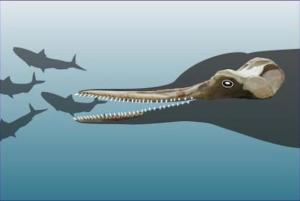
The skull and jawbone of the extinct Huaridelphis raimondii, a newly discovered squalodelphinid species …
The dusty Pisco-Ica desert stretches along the coast of
southern Peru, but more than 16 million years ago it may have been
covered with sparkling water and home to a now-extinct family of
dolphins, known as squalodelphinids, according to new findings.
The desert is a
haven for marine fossil hunters — paleontologists have found whales
with fossilized baleen, a giant raptorial sperm whale and a dolphin that
resembles a walrus, researchers say.
The
new findings include the fossils of three dolphins, two of which have
well-preserved skulls. A thorough skeletal analysis suggests the
dolphins are not only a new species but also related to the endangered South Asian river dolphins living in the Indus and Ganges rivers in India today, the researchers found.
"The
quality of the fossils places these specimens as some of the
best-preserved members of this rare family," lead study author Olivier
Lambert, of the Institut Royal des Sciences Naturelles de Belgique, said
in a statement.
River
dolphins are an unusual breed. Unlike other dolphins, they live in muddy
freshwater rivers and estuaries, and they have a long, narrow, toothy
beak and small eyes with poor vision, said Jonathan Geisler, an
associate professor of anatomy at the New York Institute of Technology,
who was not involved in the study.
The three fossils do not appear to be ancestors of other river dolphins,
including those of the Amazon or the Yangtze rivers, the latter of
which may be extinct, said John Gatesy, an associate professor of
biology at University of California, Riverside, who was not involved in
the study.
"They're three of a kind," Gatesy said. "Three independent lineages."
Researchers
have long tried to determine how river dolphins fit into the family
tree. "It's not normal for a whale or a dolphin to live in freshwater
these days," Gatesy said. "What seems to have happened is they've
independently adapted to living in freshwater conditions."
The new findings help answer that question, at least for the South Asian river dolphins, experts say.
"It's
helping flesh out this pretty poorly known extinct family that helps
tie this oddball living species into the evolutionary tree," Geisler
said.
Researchers have
uncovered other squalodelphinid specimens in Argentina, France, Italy
and on the East Coast of the United States, but fossils of these
medium-size dolphins are still rare. The modern families of tooth
whales, porpoises and dolphins diverged in the early Miocene epoch, about 20 million to 24 million years ago, making any marine fossils from that time period valuable, Geisler said.
The new, extinct species was named Huaridelphis raimondii,
after the ancient Huari culture of the south-central Andes and coastal
area of Peru that existed from A.D. 500 to 1000, and "delphis," which is
Latin for dolphin. The species name celebrates Italian scientist
Antonio Raimondi (1826-1890), who found fossils of whales in Peru, the
study reports.
Given the
abundance of fossils in the Pisco-Ica desert, paleontologists may soon
find and name other squalodelphinid remains, Giovanni Bianucci, of the
Universitá degli Studi di Pisa and an author on the study, said in a
statement.
"Considering the
richness of the fossil localities recently discovered, other new extinct
dolphins from the same geological age will certainly soon be found and
studied," Bianucci said.
The study was published today (Sept. 9) in the journal Vertebrate Paleontology.

No comments:
Post a Comment